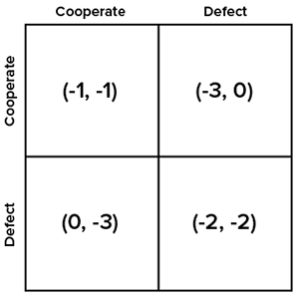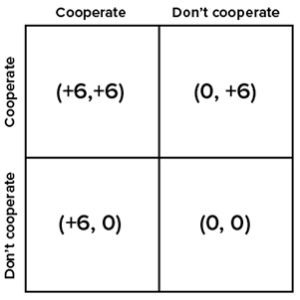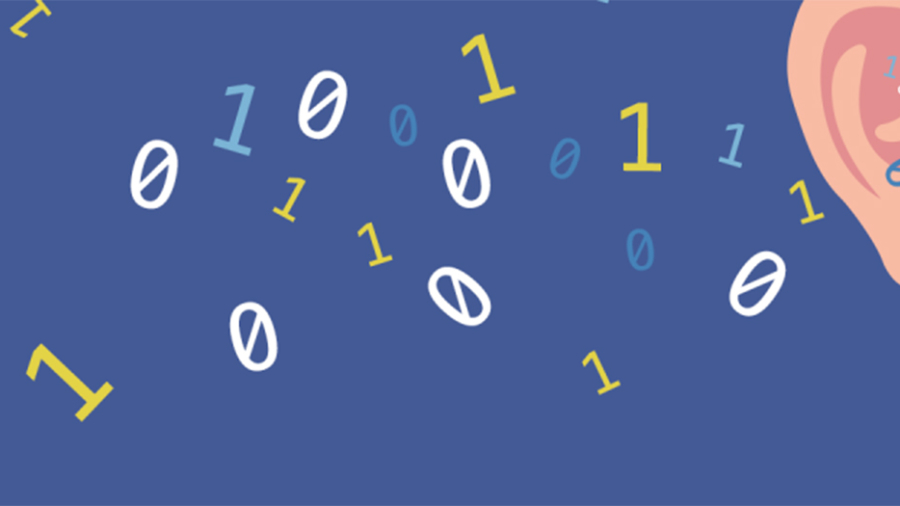An intro to the prisoner’s dilemma
Bad news: you and your partner are picked up for a crime and put in separate cells. Each of you is given the option to either stay silent (cooperate) or rat out their partner (defect / not-cooperate). If you choose to cooperate and your partner does as well, you both get one year in jail, but if your partner doesn’t cooperate and rats you out, you get three. On the other hand, if you choose to rat out your partner yourself and they stay silent, you get to walk free. However, if both of you choose to talk (not-cooperate), you both get two years. You are not particularly close with your partner and want to minimize your own time in jail. What do you do? If you need to think it over, a representation of the options and results is given below.

Upon pondering the situation, you and your partner find yourself in, you likely discover that defecting is the most attractive option every time. Regardless of what your partner chooses, you will always be better off if you choose to defect (not cooperate). Because your partner thinks the same way, he will not collaborate either. As a result, you will end up in a suboptimal situation where there is no cooperation, while both of you would have been better off if you had both chosen to cooperate.
The prisoner’s dilemma has been applied to many decision and cooperation problems over the years, but not yet to the concept of data-sharing in a B2B context. A shame, since insights in the prisoner’s dilemma can teach us a lot about why we do not share our data, and how we can start remedying that. In this think piece, we examine a modified version of the prisoner’s dilemma called the ‘data sharing dilemma’.
The data sharing dilemma
While you and I may not find ourselves in a criminal situation any time soon, we find ourselves in a prisoner’s dilemma of our own when deciding if we want to share data with other companies. This dilemma is visualized as the ‘data sharing dilemma’ in table 1.
The basic premise of the setup is that the direct cost and risks of sharing data or insights with another company amount to -1, while having a partner that cooperates with you in this way imparts much larger gains, represented by our number ‘6’. This cooperation can be the company sharing their data with you, or sharing insights based on the data you’ve shared with them.

Clearly, if both companies cooperate, both pay the price for sharing data or insights (-1), but gain the gains as well (5), amounting to a scoreboard of +5/+5 for each company. However, if one company cooperates (for instance: provides data), but the other does not reciprocate by sharing their own data or insights, the cooperating company is left with just the costs and not the gains (-1/6), while the other company has just the gains of data shared with them and none of the costs. To stay safe, we might choose not to cooperate at all, much like the prisoners in our story (0/0). From a rational perspective, this does seem to be the most logical choice.
In the end, our choices come down to answering a few questions: Do we trust other companies to collaborate with us, or will they only use our data to further their own business? Are we prepared to pay the costs of sharing our data for future gains beyond our control? Are we prepared to take the risk of cooperating, or do we stay in our safe yet suboptimal situation of not doing so? The fact that the potential of data sharing and collaboration has been widely acknowledged, but that the process itself is still fairly rare, seems to answer our question. While this seems a pessimistic view on the future of data sharing, the prisoner’s dilemma can be beaten by tweaking the situation the decision makers find themselves in.
Solving the prisoner’s dilemma
If we want to encourage data sharing, we need to understand how to break through the stalemate created by the prisoner’s dilemma. There are a few ways to do so, which can be applied to encourage data sharing collaboration in a B2B context.
1. Reduce risks and costs of data sharing
Sharing data often comes with a variety of costs and risks. In our modified example, this is represented by the -1 in our matrix. In the instance that both parties choose to collaborate, these costs and risks are compensated many times over by the results. However, if this doesn’t happen, data sharing only incurs costs and possible fines for the collaborating party, while the other party profits from a large reward without having to pay this cost. Why would anyone want to pay these costs without a guaranteed payoff?

This part of our dilemma holding back data sharing, can be solved by mitigating the cost and risk of data sharing. If we can make cooperating virtually ‘free’ (that is, without substantial cost and risk), this will lead to a different scenario. Since there is no significant cost to sharing, the ideal gains in our ‘cooperate’ situation are the same as the gains in the ‘don’t cooperate’ situation, since no costs needed to be subtracted. It is also less risky to share data, as is shown by the lack of minuses in the table.
By reducing the costs and risks of sharing data or insights, we can lower, or even remove, that early hurdle that prevents cooperation. Easy, safe ways of sharing, then, are part of the solution towards ensuring more data sharing and data collaboration. Solutions and platforms for sharing data in this way are one the rise, and we are happy to do our part with our Data Stream Manager. The DSM allows companies to share data easily and safely, among other features allowing the sharer to determine what data can and cannot be used for.
2. Establish contracts and/or outside regulation
One of the problems of the classic prisoner’s dilemma is that there are no real repercussions to not cooperating. If these are added (for instance by imagining a scenario of sequential prisoner’s dilemma’s where contestants indicate using a tit-for-that strategy, in which they will betray the next round if they are betrayed), cooperation is much more frequent.

In table 2, we see a similar issue in the data sharing dilemma: there are no repercussions for not cooperating, even when a partner does choose to do so. A company that cooperates by sharing information or still gets the same rewards as a company that only uses shared data for its own gains without sharing its own data or insights. We can overcome this by making non-cooperation costlier, reducing the gain for non-cooperation below the one for collaboration. This is the situation presented in table 3. Clearly, the rational choice in this table is to cooperate.
We can create the situation in table 3 by setting up a good contract or data sharing agreement between businesses. This allows companies to specify how and when data can be shared between businesses, and apply penalties to ‘non-cooperative behaviour. If companies beforehand specify that they will both share data with each other, which will be processed under a set of conditions, an enforceable data sharing agreement ensures that notdoing so comes at a cost. By coming to an agreement about data sharing with other companies before sharing data, cooperation becomes a more attractive option over non-cooperation. While this essentially solves the data sharing dilemma before it truly happens, companies need to be willing to sign such an agreement in the first place. For this to happen, the third point solution to the dilemma is invaluable.
3. Build trust between companies based on shared motivations, goals and values
The third solution to the prisoner’s dilemma is one which theoretically works even without the previous solutions: mutual trust. Two friends placed in the prisoner’s dilemma will be much less likely to betray each other (that is, not collaborate with each other). In the same way, establishing a foundation of shared values with your fellow company is a strong force in ensuring cooperation and collaboration. When approaching another company to set up a data sharing agreement, make sure that both parties understand where the value is in collaborating and how both parties can profit from it. Truly cooperative data sharing will be much more likely under these conditions, especially when supplemented by the solutions above.
Continue to think about collaboration
Choosing to share your company’s data is not always an easy choice; it often incurs costs and risks. Additionally, it might not always be the most rational choice, as we see in the first version of our data sharing dilemma. However, the potential of data cooperation and collaboration is great, as evidenced by a the ‘study on data sharing between companies in Europe’ commissioned by the European Commission. Therefore, thinking about data sharing and what is holding us back from practicing it more, is a worthy avenue to explore. This think piece demonstrates just one way of thinking about data collaboration and cooperation, using a well-known (thought) experiment on collaboration. We acknowledge that this text presents a somewhat oversimplified scenario of the complex issue of data sharing, but hope that this will trigger you, the reader, to think about this topic in a different way. We invite everyone to continue the discourse with us about the how’s and why (not)’s of data sharing, cooperation and collaboration!











 Feel free to contact me, and I will be more than happy to answer all of your questions.
Feel free to contact me, and I will be more than happy to answer all of your questions.